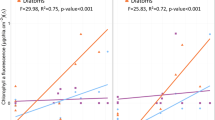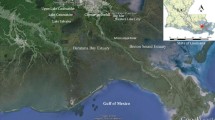Abstract
Widespread use of agrochemicals increases their likelihood of entering aquatic systems in mixture. Despite different modes of action, atrazine (herbicide) and tetracycline (antibiotic) adversely affect non-target photosynthetic organisms individually, but the effects of simultaneous exposure to both contaminants are untested. We created microcosms containing microalgae (Chlorella sp.), floating macrophytes (Lemna minor), and a zooplankton grazer (Daphnia magna). Microcosms were exposed to environmentally relevant concentrations of atrazine and tetracycline, alone and together, for 10 days. Atrazine decreased Chlorella sp. abundance, but not enough to reduce food availability to D. magna whose reproduction and mortality were unaffected. In contrast, tetracycline and atrazine appeared to have additive effects on L. minor abundance and growth inhibition. These additive adverse effects suggest increased potential for L. minor population decline over the long term, and potential for altered species interactions in aquatic systems receiving agricultural runoff.



Similar content being viewed by others
References
Arar EJ, Collins GB (1997) In vitro determination of chlorophyll a and pheophytin a in marine and freshwater algae by fluorescence. EPA Method 445
Baciak M, Sikorski Ł, Piotrowicz-Cieślak AI, Adomas B (2016) Content of biogenic amines in Lemna minor (common duckweed) growing in medium contaminated with tetracycline. Aquat Toxicol 180:95–102
Boxall ABA, Kolpin DW, Halling-Sørensen B, Tolls J (2003) Are veterinary medicines causing environmental risks? Environ Sci Technol 15:286A–294A
Chopra I, Roberts M (2001) Tetracycline antibiotics: mode of action, applications, molecular biology, and epidemiology of bacterial resistance. Microbiol Mol Biol Rev 62:232–260
DeLorenzo ME, Serrano L (2003) Individual and mixture toxicity of three pesticides; atrazine, chlorpyrifos, and chlorothalonil to the marine phytoplankton species Dunaliella tertiolecta. J Environ Sci Health 38:529–538
DeNoyelles F, Kettle WD, Sinn DE (1982) The responses of plankton communities in experimental ponds to atrazine, the most heavily used pesticide in the United States. Ecology 63:1285–1293
Ebert D (2005) Ecology, epidemiology, and evolution of parasitism in Daphnia. National Library of Medicine (US), National Center for Biotechnology, Bethesda, MD
Faust M, Altenburger R, Backhaus T, Bodeker W, Scholze M, Grimme LH (2000) Predictive assessment of the aquatic toxicity of multiple chemical mixtures. J Environ Qual 29:1063–1068
Forney DR, Davis DE (1981) Effects of low concentrations of herbicides on submersed aquatic plants. Weed Sci 29:677–685
Fuhrer G (1999) The quality of our nation’s waters: nutrients and pesticides. DIANE Publishing, Darby, pp 57–79
González-Pleiter M, Gonzalo S, Rodea-Palomares I, Leganés F, Rosal R, Boltes K, Marco E, Fernández-Piñas F (2013) Toxicity of five antibiotics and their mixtures towards photosynthetic aquatic organisms: implications for environmental risk assessment. Water Res 47:2050–2064
Graymore M, Stagnitti F, Allinson G (2001) Impacts of atrazine in aquatic ecosystems. Environ Int 26:483–495
Halling-Sørensen B, Nielsen SN, Lanzky PF, Ingerslev F, Holten Lützhoft HC, Jørgensen SE (1998) Occurrence, fate, effects of pharmaceutical substances in the environment—a review. Chemosphere 36:357–393
Hoberg JR (1991) Atrazine technical—toxicity to the duckweed (Lemna gibba). In: SLI Report 93-11-5053. Springborn Laboratories, Wareham
Ishizawa H, Kuroda M, Morikawa M, Ike M (2017) Differential oxidative and antioxidative response of duckweed Lemna minor toward plant growth promoting/inhibiting bacteria. Plant Physiol Biochem 118:667–673
Karthikeyan KG, Meyer MT (2006) Occurrence of antibiotics in wastewater treatment facilities in Wisconsin, USA. Sci Total Environ 361:196–207
Kim HY, Lee MJ, Yu SH, Kim SD (2012) The individual and population effects of tetracycline on Daphnia magna in multigenerational exposure. Ecotoxicology 21:993–1002
Knauert S, Escher B, Singer H, Hollender J, Knauer K (2008) Mixture toxicity of three photosystem II inhibitors (atrazine, isoproturon, and diuron) toward photosynthesis of freshwater phytoplankton studied in outdoor mesocosms. Environ Sci Technol 42:6424–6430
Lampert W, Fleckner W, Pott E, Schober U, Störkel KU (1989) Herbicide effects on planktonic systems of different complexity. Hydrobiologia 188–189:415–424
Marshall GC (2009) Assessing the behavioral and physiological responses of three aquatic invertebrates to tributyltin and atrazine in a multi-species, early warning biomonitoring technology. Dissertation, Ryerson University
Munch JW (1995) Determination of nitrogen- and phosphorous-containing pesticides in water by gas chromatography with a nitrogen-phosphorous detector. EPA Method 507
Okomoda VT, Solomon SG, Ataguba GA (2012) Potential uses of the family Lemnaceae. J Agric Vet Sci 4:1–14
Pomati F, Netting AG, Calamari D, Neilan BA (2004) Effects of erythromycin, tetracycline and ibuprofen on the growth of Synechocystis sp. and Lemna minor. Aquat Toxicol 67:387–396
Powell KW, Cope WG, LePrevost CE, Augspurger T, McCarthy AM, Shea D (2017) A retrospective analysis of agricultural herbicides in surface water reveals risk plausibility for declines in submerged aquatic vegetation. Toxics 5(21):1–13
Quinlan EL, Nietch CT, Blocksom K, Lazorchak JM, Batt AL, Griffiths R, Klemm DJ (2011) Temporal dynamics of periphyton exposed to tetracycline in stream mesocosms. Environ Sci Technol 45(24):10684–10690
Schreinemakers WAC (1984) Effects of metal ions on growth of and ion absorption by Spirodela polyrhiza (L). Schleiden effects of iron, magnesium and zinc. Zeitschrift fur Pflanzenphysiologie 114:123–129
Seguin F, Leboulanger C, Rimet F, Druart JC, Bérard A (2001) Effects of atrazine and nicosulfuron on phytoplankton in systems of increasing complexity. Arch Environ Contam Toxicol 40:198–208
Seguin F, Le Bihan F, Leboulanger C, Bérard A (2002) A risk assessment of pollution: induction of atrazine tolerance in phytoplankton communities in freshwater outdoor mesocosms, using chlorophyll fluorescence as an endpoint. Water Res 36:3227–3236
Solomon KR, Baker DB, Richards RP, Dixon KR, Klaine SJ, La Point TW, Kendall RJ, Weisskopf CP, Giddings JM, Giesy, JP, Hall Jr, LW, Williams WM (1996) Ecological risk assessment of atrazine in North America surface waters. Environ Toxicol Chem 15:31–76
Torres AMR, O’Flaherty LM (1976) Influence of pesticides on Chlorella, Chlorococcum, Stigeoclonium (Chlorophyceae), Tribonema, Vaucheria (Xanthophyccae) and Oscillatoria (Cyanophyceae). Phycologia 15:25–36
United States Environmental Protection Agency (1996) Prevention, Pesticides and Toxic Substances (7101), EPA712-C-96-156, Ecological Effects Test Guidelines OPPTS 850.4400, Aquatic Plant Toxicology Test Using Lemna spp., Tiers I and II
Yang S, Cha J, Carlson K (2004) Quantitative determination of trace concentrations of tetracycline and sulfonamide antibiotics in surface water using solid-phase extraction and liquid chromatography/ion trap tandem mass spectrometry. Rapid Commun Mass Spectrom 18:2131–2145
Yang W, Tang Z, Zhou F, Zhang W, Song L (2013) Toxicity studies of tetracycline on Microcystis aeruginosa and Selenastrum capricornutum. Environ Toxicol Pharmacol 35:320–324
Acknowledgements
We thank the Chandler Foundation, the Department of Biology, the Georgia Southern University Honors Program Undergraduate Research Fund, and the Student Government Association for funding awards to the first author who completed this study under the mentorship of the second author. We also thank C. R. Chandler for statistical advice and J. Duff, L. Latzsch and A. Wagner for assistance with the experiment.
Author information
Authors and Affiliations
Corresponding author
Rights and permissions
About this article
Cite this article
Kelly, M.R., Cohen, R.A. The Effects of an Herbicide and Antibiotic Mixture on Aquatic Primary Producers and Grazers. Bull Environ Contam Toxicol 101, 556–561 (2018). https://doi.org/10.1007/s00128-018-2451-0
Received:
Accepted:
Published:
Issue Date:
DOI: https://doi.org/10.1007/s00128-018-2451-0




